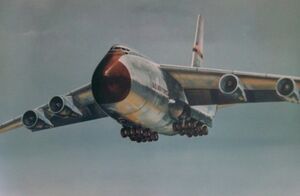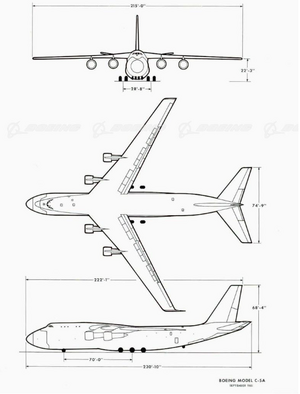Laurein C10M Atlas: Difference between revisions
(Created page with "{|{{Infobox aircraft begin |name = Laurein C10M Atlas |image = Image:C10m_approach.jpg |caption = A C10M2 of the Meridonian Air Forces on appro...") |
(No difference)
|
Revision as of 14:49, 5 February 2023
| Laurein C10M Atlas | |
|---|---|

| |
| A C10M2 of the Meridonian Air Forces on approach to landing | |
| Role | Strategic airlifter |
| National origin | |
| Manufacturer | Laurein Aircraft Company |
| First flight | 2 July 1971 |
| Introduction | 3 June 1972 |
| Status | In active service |
| Primary user | |
| Produced | 1969-present |
| Number built | 81 |
The Laurein C10M Atlas is a large Meridonian military transport aircraft, designed and produced by Laurein Aircraft Company. Designed to meet a requirement of the Meridonian Air Forces to deliver and deploy outsized cargo and high payloads, the C10M design proposed by Laurein won a lengthy competition for such a design primarily due to the fact that a large amount of components to be used on the design were already in development or production for the airline's L140 airliner, reducing overall costs. A small number of C10M aircraft have been built and sold to civil cargo transport companies, although sales of these nature were prohibited after 1987.
The C10M was designed to be able to carry all air-certifiable cargo in the inventory of the Meridon Defense Forces, including main battle tanks, outsized loads, and heavy industrial machinery. It is also capable of conducting parachute drop operations of cargo and airborne infantry.
The C10M3 is a recently overhauled version of the aircraft designed to extend its service life until at least 2050, pending the fielding of a replacement airframe. The few civilian variants of this aircraft that exist are designated as C/L-110M, of which at least five are known to be actively flying as of 2022.
Development
Design
The C10M was born out of a defense white paper in 1965 that found that the Meridonian Air Force's Air Transport and Sustainment Command (ATSC) with its current fleet of C8M Pecheron and TBD aircraft would not be capable of conducting the projected airlift missions of the future, which required higher payload capacity and the ability to rapidly transport and deploy outsized cargo around the world. Particularly, both the Army and Navy were in need of an aircraft that could rapidly deliver large quantities of defensive fortification materials and midsize patrol boats
The F5M was designed based both on experience flying the F4M Spectre as a naval fighter, and on perceived needs of the carrier air wing in conducting force projection and self-defense operations. Seeing the threat of missile-armed bomber flights as an emerging threat towards the carrier group, the F5M was designed with long range and an air-to-air focus in mind while ground attack missions would be relegated to the F4, a role in which it had proved itself more than capable of performing. Like the F4M, the F5M was designed around a two-crew design with a pilot and radar intercept officer deemed better able to manage air intercepts.
A number of emerging technologies were included in its design, chief among those its variable geometry wings, which move forward for slower flight and move rearward for faster supersonic flight. It included a number of innovative control surfaces to improve its low-speed handling, which was necessary for carrier operations. Originally it was powered by a pair Altern MG-410 afterburning turbofan engines, which proved to be prone to compressor stall incidents at high angles of attack, and was later replaced by Hollon FT80 engines, which provided a substantial increase in both reliability and performance. Both engines are supplied with rectangular intakes equipped with movable ramps, bleed doors and other such functions. Landing gear is provided in a tricycle arrangement, and is reinforced for carrier landings.
The Lynx's weapons system was based around the utilization of the TAI-81 X band pulse-doppler radar, the first in use capable of launching using track while scan; and the MUA-55 Phoenix missile, a very long range air to air missile intended for intercepting targets at ranges in excess of 100 nautical miles. Utilizing the Phoenix for long-range intercepts and the MUA-7 Falcon for escort and air intercept missions. From the outset it was armed with the Mark 40 20mm cannon in a nose mount with 600 rounds of ammunition. The Lynx carries a radar warning receiver, chaff, flare, and models from the F5M4 and later are integrated with electronics countermeasures systems to defend against incoming missiles.
The Lynx featured pioneering developments in pilot interface in Meridonian fighter craft, including the first multi-function HUD, hands-on throttle and stick (HOTAS), and early multifunction displays, features which would prove instrumental in the design of later combat aircraft.
Lynx models from the F5M6 and later improve vastly upon the original design of the base model F5Ms (F5M through F5M5). The F5M6 introduced leading-edge extensions (LEX) to the wing root, enhanced visibility cockpit glass, full multifunction glass flight displays, integrated NAV/attack FLIR pods, and HMD integration, as well as allowing for the carrying of standoff weaponry including cruise, anti-satellite, and anti-ship missiles. The so-called "Super Lynx" upgrade vastly improved performance in nearly all aspects over the airframe. F5M7 upgrades, first fielded by the Air Force, feature a full glass display replacing all 'steam gauge' instruments.
Operational History
Variants
- F5M
- Initial operational variant, first supplied to the Meridonian Navy in 1974. As initially supplied, it was almost purely an interceptor and air superiority aircraft, with marginal ground strike capability added through unguided bombs and rockets only. It was powered by Altern MG-410 afterburning turbofans, which proved unreliable and prone to compressor stalls especially at high AOAs. All F5M models were upgraded to F5M2 standard by 1983.
- F5M2
- Upgraded variant of the initial F5M2 variant addressing numerous concerns by the Navy and adding operational requirements for use by the Air Force. Wing vanes mounted in the glove box were permanently removed, and the addition of a second CRT display for navigation was included. Integration with civilian navigational sources including VOR and ILS were integrated for use, including a HUD approach mode. Automatic Carrier Landing System (ACLS) capability was added to this model. A total of 103 F5Ms were upgraded, and an additional 242 were produced to F5M2 standard.
- F5M3
- Upgrade program conducted in the mid-late 1980s, its primary improvement was replacing the unreliable Altern MG-410 engines with Hollon FT80s, which themselves were a product of the failed Air Supremacy Initiative. Performance increases were substantial, allowing even a fully-loaded fighter to take off without the use of afterburner, a feat unmatched by any other model of naval fighter before or since. Integration was added for the TANDEM NAVLFIR system, including the employment of laser-guided bombs.
- F5M4
- The F5M4 was an enhancement project designed to cover perceived gaps in employment capabilities. It was equipped with an enhanced TA-902E radar which mitigated the previous TAI-81's shortfalls to clutter detection, processing speed, and jamming capabilities, and included integration of an air-to-ground radar. New cockpit displays, including the first multifunction displays and an enhanced heads-up display, were added. The F5M4 was also integrated with an inbuilt ECM jammer and provided for the employment of GPS-guided bombs utilizing the TANDEM II pod. Deliveries began in 1992 and concluded in 1999.
- F5M5
- Primarily an enhancement program to upgrade F5M2 and F5M3 models to current standards in the mid 90s to early 2000s, the F5M5 label was also issued to upgraded F5M4s, to which the modifications were primarily software-related. The F5M5 included integration of a host of new weapons systems, including the MUA-120 CAIMS, MUB-65, and CUS-154 SOGW.
- F5M6
- The F5M6, or "Super Lynx", was a comprehensive re-drawing and enhancement program of the base airframe first produced in 1998. The F5M6 introduced a wide range of new upgrades to the airframe design. Equipped with the enhanced Hollon FT80E engines that provided additional fuel efficiency over the base model FT80s, the F5M6's efficiency and handling was also increased by redesigned leading edges, as well as leading edge extensions and new control surfaces. The F5M6 integrated a fly-by-wire system, a further enhanced TA-910 radar, integrated NAV/attack FLIR, full multifunctional displays for both pilot and RIO, redesigned cockpit glass, integration for helmet-mounted cuing systems, integration of stand off weaponry including anti-shipping, cruise missile and anti-satellite weaponry. Deliveries began in 1999 to the Navy and the Air Force in 2000, and deliveries were completed in 2014.
- F5M7
First fielded by the Air Force in 2020, the F5M7 is a modernization program that saw further flight control enhancements, including a full-panel multifunctional display for the pilot and RIO, as well as the redesign of some airframe components to decrease weight, increase performance, or increase longevity. The Navy received its first batch of upgraded F5M7 models in 2021.
Operators
Current Operators
 Meridon- 662 in service of F5M6 and F5M7 variants across both Air Forces and Navy.
Meridon- 662 in service of F5M6 and F5M7 variants across both Air Forces and Navy.
Former Operators
Specifications (C10M3)
General Characteristics
- Crew: 2
- Length: 62 ft 9 in (19.13m)
- Wingspan: 64 ft 1.5 in (19.545 m)
- Swept wingspan: 38 ft 2.5 in (11.646 m) swept
- Height: 16 ft (4.9 m)
- Wing Area: 565 sq ft (52.5 m2) wings only
- Empty Weight: 45,624 lb (20,694 kg)
- Max Takeoff Weight: 76,820 lb (34,844 kg)
- Powerplant: 2 × Hollon FT80E afterburning turbofans
- Fuel Capacity: 17,000lb internal, 2x optional 267gal (1,756lb/797kg) external tanks
Performance
- Maximum Speed: Mach 2.41 (2,975 km/h, 1,849 mph) at altitude
- Service Ceiling: 55,000 ft (16,764 m) +
- Rate of Climb: 45,000 ft/min plus (230 m/s)
- Wing Loading: 96 lb/sq ft (470 kg/m2)
- Thrust/Weight: 1.14, clean configuration, 50*
Armament
- Guns: 1 × Mark 40 20mm cannon with 600 rounds
- Payload: 10 hardpoints total: 4 between engine fairing, 2 under engine nacelle, 2 per wing glove (1 wing glove per wing) with capacity of 15,000lbs (6,803 kg) of munition to carry the following:


